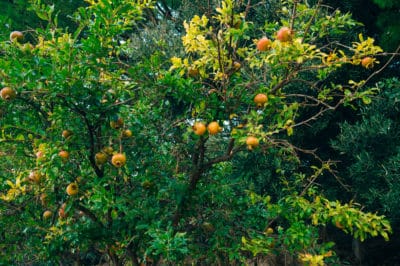Recognizing a Pomegranate
It’s easy to determine whether a tree is a pomegranate if it has fruit hanging on it, even though that fruit might come in a variety of colors including the more common red. The flowers are also striking – bright red, orange and more rarely pink. In other respects, look for a smallish tree or sprawling shrub with small glossy light green leaves and spines or thorns on the branches.
Many Choices
You may be able to choose among as many as 500 pomegranate cultivars, although you should make sure you have the right climate. Pomegranates generally do best in USDA Zones 8 to 10, but a few will grow in colder areas like Zone 6 or 7. These cultivars are usually available:
- Angel Red
- Early Wonderful
- Eversweet
- Granada
- Pink Satin
- Sweet
- Wonderful
Commercial Pomegranate Trees
Commercial growers are the group most likely to grow what can truly be called a pomegranate tee. They prune the plants to a single trunk and trim back the upper branches to make care and harvesting easier. Although some varieties can reach nearly 30 feet in height, commercial trees are more likely to be topped and pruned around 12 feet.
The Flowers
Even if you have never seen a pomegranate tree, you could probably recognize it by the flowers. Usually a brilliant orange, orange-red or red – although one cultivar is pink – they appear in bursts throughout the growing season. The three- to five-petaled flowers have bright yellow stamens and a sweet fragrance. Some are ruffled and edged in cream or white.
Shrub, Not a Tree
If left unpruned, most pomegranates will produce lots of suckers and small, flexible branches. This characteristic is one of the things that makes them valuable bonsai specimens, as they can be trained into interesting shapes. In the garden, they can also be trained and pruned for looks rather than fruit production.
The Trunk
Young pomegranate trees often have a single or divided straight trunk. As the tree ages, the trunk may become gnarled and twisted, a condition that can be helped along with judicious pruning or training. The bark is smooth in young trees and of a grayish brown color, but becomes fissured, rough and dark gray to deep brown as the plants age.
